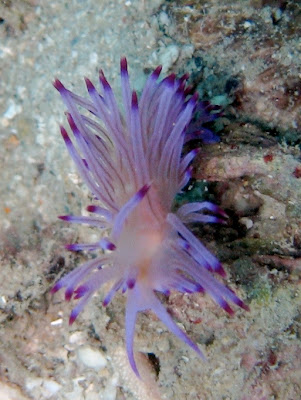Nudibranches come in all shapes and sizes, and are often multihued to either attract potential mates or to ward off would-be predators.
 Phyllidiella pustulosa(?)
Phyllidiella pustulosa(?)Sometimes I find it quite difficult to differentiate between different species of nudibranches because they may look quite similar are oftentimes differentiated by rather obscure features like the colour of their antannae or the type of food they eat etc.
This one looks almost like the two below but apparently they're of different species, I don't know why.
 Pair of Phyllidia varicosa going for a walk after lunch.....
Pair of Phyllidia varicosa going for a walk after lunch.....Meanwhile this little fella was left all alone.... poor guy.
Flabellina rubrolineata
That's latin for red-lined erm... flabellina. You can't see the red line because it's on its underbelly. Pair of Risbecia tryoni playing tag. Thanks Asther for the correction. Appreciate it!
Pair of Risbecia tryoni playing tag. Thanks Asther for the correction. Appreciate it!This is the first time I've seen this particular critter, and I can proudly say I was the only one in my dive team who spotted it.... hehehe
 This is a pair of Phyllidiela pustulosa out for a walk after dinner. How romantic! Hehehe
This is a pair of Phyllidiela pustulosa out for a walk after dinner. How romantic! Hehehe








2 comments:
Hehehe... the "Gymnodoris sp." is actually Risbecia tryoni. ;)
Hey are you a professional journalist? This article is very well written, as compared to most other blogs i saw today….
anyhow thanks for the good read!
Post a Comment